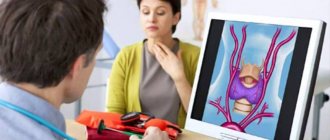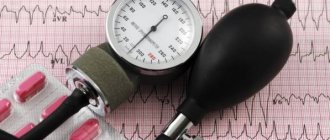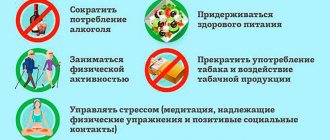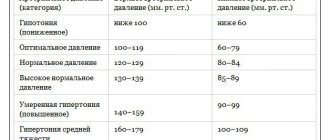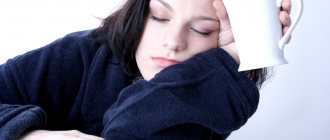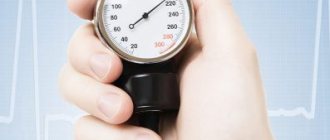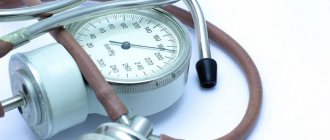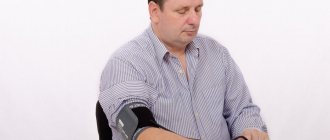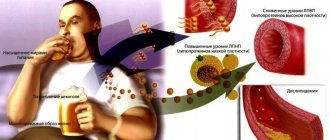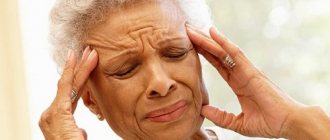Hypertension is a disease that is often associated with epithets such as “insidious” and “cruel.” She is even called the “silent killer.” These words were not invented to intimidate, but to convey to people at risk (and this is literally every adult) that the disease cannot be ignored.
Indeed, it can develop without symptoms for a long time. But, rather, it would be correct to say that they go unnoticed. Who doesn't get a headache from time to time? Who doesn’t sometimes have pressure in the back of their head, dots appear before their eyes, or tinnitus? But often, with such symptoms, the thought of pressure does not even cross your mind.
Blood pressure rises to 140/100: what does this mean?
If the pressure increases one-time, episodically, as a result of some irritant, this is not hypertension. Anxiety, taking medications with this side effect, even the flu can lead to increased blood pressure. But if the numbers on the tonometer are persistently increased, there is almost no doubt - this is arterial hypertension.
It is a mistake to think that pressure 140 over 100 is normal, that this is an individual indicator, or, even better, working pressure. It’s time to accept the fact that modern doctors have abolished this term. There is a target pressure, there is a normal pressure, and there is an optimal pressure. But working is partly even a harmful concept: it allows a person without a medical education to decide for himself what his norm is.
So, everyone knows that 120/80 is a good blood pressure reading. By the way, good does not mean excellent. According to the latest data, the optimal blood pressure values include the ratio 110-115/70-75. If you have such persistent indicators, we can only congratulate you. But 120/80 is still the norm that people with high blood pressure should strive for.
The first digit in the values of 140/100 means systolic pressure, the second – diastolic. As you can see, both upper and lower pressure exceed the norm. Such values are referred to as the first degree of hypertension or mild hypertension. It is this pressure that often has no symptoms, which is why hypertension is not always diagnosed at the beginning of its development. More often, a patient comes to the doctor with moderate hypertension.
First aid
In stressful situations, it is difficult to control blood pressure, as well as predict the occurrence of an attack. Therefore, it is important to know what to do if the pressure rises to 140/100 and a sharp deterioration in health for both the patient and his relatives, so as not to panic and provide timely assistance:
- It is convenient to lay the patient down; the body position should be semi-recumbent.
- The legs need to be warmed to increase the flow of blood from the brain.
- Open the windows in the room to provide fresh air.
- Remove clothing that makes breathing difficult.
- Periodically measure pressure and record all changes.
- Try to console and calm the patient. Take deep breaths and exhalations with him for 10 minutes.
Emergency care for hypertension
If, despite all the efforts made, the patient does not get better, or the condition worsens, then it is necessary to call an ambulance or a paramedic on duty. It is prohibited to give any medications without a prescription and to self-medicate so as not to aggravate the situation or cause harm.
The exception is sedatives and sedatives: Valerian tincture, as well as drugs such as Nitroglycerin, Nitromint, if this is not the first attack and a specialist has already recommended them earlier.
Pressure 140 over 100: possible causes
Why did this happen to me? Why do I need this? Questions that probably every person asked himself when he was diagnosed with hypertension. It is difficult to answer these questions completely, but there are certain assumptions.
If you want to know, the question of the mechanisms of development of hypertension has not yet been settled. Scientists have not yet reached a unanimous opinion on what triggers pathology in the body.
The theory of the hormonal origin of the disease is being carefully studied: if we assume that the vascular walls synthesize several types of hormones, then some of these hormones, when changing their quantity (or changing their functions), can affect the narrowing of blood vessels. But there is no exact data presented to the general public yet.
But the factors predisposing to hypertension are absolutely known:
- Stress and overwork are new discoveries of the last 150-200 years; scientific and technological progress and active urbanization of the population have significantly increased human life expectancy, but also increased its speed. Now he needs to do more, be able to do more, process information faster, etc. Stress does not arise due to mortal danger in the form of wild animals, fires, disastrous epidemics, etc. There is more and more so-called household stress in our lives, which occurs almost every day. And the body has to mobilize not from time to time, but very often. Too often, one might say. This depletes vital systems. And the cardiovascular system is one of the first to suffer.
- Genetic inheritance is a given, but it’s up to you to decide whether to accept it obediently. Someone will silently agree that almost everyone in the family was hypertensive, and they will not be surprised by such a diagnosis. Someone will understand that he is at risk and will direct his efforts towards preventing the disease.
- Poor diet, overeating, excess weight. The way you look is the way you eat and the way you move. There is no escape from this; your appearance will always screen your lifestyle. The more refined foods on the menu, the more fried, floury, sweet, and salty it contains, the faster your body’s resources are spent. The faster you age, the faster your organs wear out.
- Bad habits. In smokers, blood pressure may “jump.” In their youth, some nicotine addicts say, not without pride, that their blood pressure is even slightly below normal, which means they definitely won’t have hypertension. But hypotension has never been a “vaccination” against hypertension. Moreover, if you smoke, your hypertension will develop rapidly. Alcoholism is a destruction of the body; it always hits the basic systems of the human body.
- Hormonal dysfunctions. Considering the possible hormonal nature of hypertension, such a provoking factor is logical. But even without this assumption, it is clear that any hormonal imbalance is reflected in the body. Hormones are biologically active substances that, to put it very roughly, are responsible for our health. There is a hormonal balance - there is health, if there is no balance - the whole “program” goes wrong. Blood pressure is regulated with the participation of hormones, so if you have endocrine problems, they need to be addressed.
- Congenital or acquired pathologies of the cardiovascular system (CVS). Hypertension is not always the first disease that affects the heart and blood vessels. It also happens that other pathologies of these organs cause hypertension.
Blood pressure is 140 over 100 – what this means specifically in your case needs to be decided in the doctor’s office. Examination, modern diagnostics, therapeutic tactics - without this it is impossible to competently treat hypertension.
Should the indicators be reduced?
Depending on the examination results, the doctor selects a treatment method and prescribes medications. At the initial stage, with irregular attacks, it is preferable to do without taking medications. In this case, it is recommended to change your lifestyle, adjust your daily routine, give up bad habits, and reduce your coffee consumption. It is necessary to choose light physical activity, spend more time in the fresh air, and get enough sleep.
Primary prevention of hypertension
Switching to proper nutrition is also effective: more fruits, vegetables, less flour, fatty foods, and sweets. Reducing the amount of salt in food is beneficial. The doctor also prescribes massage, special baths, and electrophoresis.
What medications should I take?
When pressure surges become more frequent and the disease progresses, it is necessary to switch to drug therapy. But what should you take to treat high blood pressure? Doctors identify the following groups of drugs.
- Diuretics. Another name is diuretics. Relieves swelling by removing excess fluid from the body. They reduce blood pressure in case of concomitant heart diseases, kidney pathology, and also in case of excess weight. The most commonly prescribed are Furosemide, Indapamide, Veroshpiron, Spironolactone.
Calcium channel blockers. Prevent vascular spasm by reducing the contraction of vessel walls. Thanks to this, the vessels dilate, blood circulation is normalized, and blood pressure returns to normal. Verapamil, Nifedipine, Amlodipine are prescribed.- Adrenergic blockers. They block the effect of adrenaline on the functioning of blood vessels, which leads to normalization of pressure. Representatives of the group: Atenolol and Betaxolol.
- Angiotensin II blockers. Indicated for high blood pressure in patients with diabetes and kidney dysfunction. Medicines have a universal effect. This group includes Losartan and Cozaar.
- ACE inhibitors. They block the enzyme responsible for the production of a substance that constricts blood vessels. Drugs: Captopril, Prestarium, Enalapril.
After a course of treatment, re-diagnosis is prescribed. If there is a slight improvement, the medications are changed or additional methods of therapy are selected.
If the pressure is 140 over 100: this is dangerous
This is dangerous - the situation is far from harmless. Blood pressure, as is known, correlates with the minute volume of blood that the heart pushes into the vasculature, as well as its resistance to blood flow. If a person is healthy, when blood is released, the vessels will respond with a decrease in tone: their lumen will expand, blood pressure will remain at its natural norm.
In hypertensive patients, regulatory mechanisms are disrupted, and the system called “heart-vessels” works according to a defective scheme. For example, with an increased heart rate, peripheral vessels do not dilate, hence the increase in blood pressure.
As a rule, with blood pressure 140 over 100, a person complains of:
- Headache;
- General malaise;
- Nausea;
- Noise in ears;
- Visual defects.
For some, the symptoms appear more clearly, while for others they are blurred. But you need to take measurements at the slightest suspicion.
Since, in any case, if a person’s blood pressure is 140 over 100, this is not the norm. The situation requires correction.
How to lower blood pressure 140/100
If you have not yet reached the doctor and decided to cure hypertension yourself, we warn you that this can only worsen the situation. If you have mild hypertension (and this is most likely the case), then your treatment will not consist of a handful of pills. In some cases, mild hypertension is tried to be treated without medication. If you give up bad habits, lose excess weight, start eating right, and engage in active physical exercise, it is more than likely that your blood pressure will decrease.
It is dangerous to ignore high blood pressure. Even if it is not felt, even if there are no visible reasons, pathological indicators cannot be maintained. You should contact a cardiologist to prescribe treatment.
What to drink with a blood pressure of 140/100 - list of medicinal groups:
- Angiotensin receptor blockers (another name is sartans). This group is represented by Losartan, Valsartan, Cardosal, Candesartan, etc.
- Diuretics (or diuretic medications). And this pharmaceutical group is represented by Furosemide, Indapamide, Hydrochlorothiazide, Veroshpiron, etc.
- Beta blockers (selective and non-selective). Perhaps, if you are hypertensive, you are already familiar with Atenolol, Pindolol, Bisaprolol, Metoprolol, etc.
- Antagonists Sa. The most famous representatives of this group are Verapamil and Diltiazem.
- Alpha adrenergic blockers. Represented by Terazosin, Proxodolol, Urorek, Artezin, etc.
- ACE inhibitors. The group is represented by Elanapril, Prestarium, Captopril, Kizinopril, etc.
Medicines are prescribed only by a doctor: some of the medications are prescription.
In the early stages of hypertension, as a rule, one name in the treatment regimen is sufficient. But even those patients who are forced to be treated with drugs of different effects today do not have to bother taking pills from different packs. You can choose a combination pharmaceutical, where two active substances with different directions are combined in one effective formula.
Treatment regimens
Therapy is etiological, that is, aimed at eliminating the root cause of the pathological condition (kidney, thyroid, and other diagnosed diseases). This is the basis of treatment. Everything else is just additional measures designed to combat only manifestations and symptoms.
The first without the second makes no sense. To solve the problem of relieving symptoms, antihypertensive drugs are prescribed (several pharmaceutical groups at once, a complex effect is most preferable).
As an auxiliary measure, adherence to an optimal drinking regimen (2 liters of fluid per day), diet, and giving up bad habits is indicated. You should not take medications without a doctor's recommendation. What this entails has already been said.
The outcome of treatment in most cases is favorable if you follow all the specialist’s recommendations and do not engage in amateur activities.
Principles of prescribing blood pressure medications
They were developed by WHO; these principles are regularly improved and supplemented with new recommendations. Over the past 20-30 years, there has been a leap in the treatment of hypertension - treatment has become more targeted and safe.
What do these principles look like:
- Therapy always begins with the lowest doses with a prediction of their effectiveness. If the effect is achieved, then treatment continues at reduced doses. If the result is negative, the doctor increases the dosage and monitors the reaction. But at the same time, the doctor also takes into account the patient’s individual tolerance to a particular drug. If side effects occur, the medicine is discontinued.
- Complete therapy does not always require pharmaceuticals alone. Combination treatment is a more preferable tactic than increasing the dose of a single prescribed drug. This helps minimize unwanted effects.
- If therapy does not produce results, you need to choose medications from another pharmaceutical group.
- Medications that work for 24 hours are considered most effective. This is a kind of guarantee of stability of blood pressure values, as well as making the patient’s life easier - he drinks one tablet once a day, at a certain time. The risk of missing a dose is very low.
If your blood pressure has increased to 140 to 100, decide with your doctor how to bring it down.
It is unacceptable to buy medicine without a prescription, take pills from a relative, roommate, etc. Be sure to read the list of contraindications in the annotation - there is always a slight danger that the doctor did not take into account some diagnosis (it might not be in the medical record, the patient himself might have forgotten/kept silent about it).
Treatment
If the pressure readings constantly remain at around 140/100 mmHg. Art. , this indicates first-degree hypertension. It is important to consult a doctor so that he can identify the exact cause and prescribe appropriate treatment.
Main directions of therapy:
- treatment of diseases that cause high blood pressure;
- use of drugs to lower blood pressure;
- normalizing sleep and rest patterns;
- reducing salt in the diet (up to 1 tsp per day);
- stopping the consumption of alcoholic beverages;
- cessation of tobacco products;
- moderate physical activity;
- weight loss;
- avoidance of stressful situations;
- limiting the consumption of drinks containing caffeine;
- reducing the amount of animal fats;
- introduction of seafood and plant-based dishes high in magnesium and potassium into the diet of hypertensive patients.
There is no need to be afraid of using medications for a long time. Modern drugs do not cause harm to the body even when taken continuously. They maintain a person’s quality of life at the proper level.
Nutritional Features
To bring your blood pressure back to normal, you should review your diet. It is advisable to replace salt with citric acid or vinegar in small quantities. A special diet based on plant foods is extremely important in the treatment of arterial hypertension.
Products that reduce blood pressure:
- hibiscus, green tea;
- watermelons, melons, as they are natural diuretics;
- dairy products, green vegetables, almonds, bananas, tuna, zucchini, oranges, dried apricots due to the main component - calcium, which actively lowers blood pressure;
- products containing magnesium: oatmeal, buckwheat, millet, black currants, beans, walnuts, carrots, beets;
- sour foods: chokeberry, grapefruit, cranberry, viburnum, quince, celery;
- garlic, as it can thin the blood.
Minimize or stop consuming the following foods:
- smoked, salted and spicy foods;
- spicy seasonings;
- sweets with butter cream;
- fatty fish;
- drinks containing caffeine;
- offal;
- fatty ice cream;
- dishes high in starch: baked goods made from white flour, semolina, corn, potatoes.
If you follow these nutritional principles, blood vessels return to normal, excess weight is lost, and blood pressure drops.
You need to eliminate foods gradually so that the body has time to adapt. In cases where moderate exercise and proper nutrition do not help, medications should be included. You should not self-medicate, as the doctor selects the drug individually.
Treatment with medications
With readings of 140 per 100 mm Hg. Art. Most often, non-drug treatment, or rather lifestyle changes, is sufficient. But if the pressure is 140 over 110 or higher, the doctor usually prescribes medications.
They also resort to drug therapy if all of the above recommendations do not help. The drugs remove excess fluid from the body, dilate blood vessels, which leads to a decrease in blood pressure.
Such drugs are divided into five groups:
- Diuretics (Furosemide, Indapamide). They remove excess fluid from the body, thereby reducing blood pressure;
- Calcium channel blockers (Verapamil, Nifedipine). Blocking calcium channels helps prevent vessel walls from contracting. Because of this, their lumen increases, blood flow returns to normal, and pressure stabilizes;
- ACE inhibitors (Enalapril, Benazepril). They are first line medications. They are used for long-term therapy and as instant-acting drugs;
- Angiotensin antagonists (Cozaar, Losartan);
- Adrenergic blockers (“Betaxolol”, “Atenolol”). With their help, the effect of adrenaline on the walls of blood vessels is blocked, which causes the pulse to become slower and the synthesis of adrenaline and norepinephrine to decrease. This group of drugs has quite a lot of side effects.
Diuretic medications are of the following types:
- Thiazide. They are the most affordable and popular among other diuretics. They not only remove fluid from the body, but also potassium, which is necessary for the full functioning of the cardiovascular system;
- Loopbacks. Quite strong remedies, but it is not advisable to use them constantly;
- Potassium-sparing. Prescribed for patients with low potassium levels in the blood.
The effect of medications is determined by the following criteria:
- the medicine is well tolerated, the patient feels well, there are no side effects;
- the upper and lower pressure decreases to normal levels.
Usually a specialist prescribes not one medicine, but several that combine well with each other. The drugs have different mechanisms of action, so at the same time they influence several factors that increase blood pressure.
Folk remedies
Relaxing massage, baths with essential oils, aromatherapy, tinctures and herbal decoctions help normalize blood pressure. They consume plants that have calming properties, a diuretic effect, improve the functioning of the heart muscle and lower blood pressure. The therapeutic course can last from 7 days to 2 months, usually followed by a break. Let's consider, if the pressure has increased 140 to 100, then what can be done to bring it down without using medications at home.
To prepare the medicine you will need:
- Grated lemon – 1 tbsp. l. ;
- Pounded cranberries – 1 tbsp. l. ;
- Chopped fresh rose hips – 1/2 tbsp. l. ;
- Honey – 1 glass.
Mix the ingredients, consume 2 times a day (morning and evening) 1 tbsp. l. The resulting product helps strengthen capillaries and increase their elasticity. The fact is that cranberries contain flavonoids; they also help in the absorption of vitamin C. Its juice contains substances necessary for the body that increase the level of proper cholesterol and antioxidants that help the functioning of the cardiovascular system. Other components of the product also have a positive effect on the human cardiovascular system.
To prepare the herbal infusion, you need the following ingredients:
- Sophora flowers – 10 g;
- Forest clear grass – 10 g;
- Meadow geranium (herb) – 10 g;
- Sweet clover grass – 5 g.
Chop the plants and mix. Pour a glass of 250 ml of boiling water into one teaspoon of the mixture and wait 15 minutes. Serve hot, you can add honey. Take twice before meals and once before going to bed.
Flaxseed is a source of unsaturated fatty acids. It should be consumed in 3 tbsp. l. per day. You can add it to salads or eat it in its pure form - this helps strengthen the vascular walls and reduces blood pressure.
Ginger is suitable for use for preventive purposes and treatment of hypertension in the first stage. Its root prevents the formation of atherosclerosis and atherosclerotic plaques, eliminates unnecessary cholesterol, helps thin the blood, relieve spasms and dilate blood vessels.
It can be drunk as tea. To do this you will need:
- Grated ginger – 2 tbsp. l. ;
- Hot water – 1 l.
Pour water over ginger and boil for ten minutes. You can add lemon, honey or sugar to the broth. The drink has a tonic effect, so it is best to drink it in the morning.
Honey is considered very effective in treating hypertension. It contains easily digestible glucose and amino acids, trace elements, vitamins and substances necessary for the body that prevent the growth of bacteria and regulate the functioning of the nervous system.
To prepare a product with honey you will need:
- Carrot juice – 20 g;
- Lemon juice – 50 g;
- Horseradish juice – 20 g;
- Honey – 1 glass.
The product should be consumed 1 tbsp. l. 3 times a day an hour before meals.
Surgical intervention
If the indicators remain stable at around 140 to 100 mmHg. Art. , blood pressure often fluctuates during drug treatment, and surgery may be required (if renal artery stenosis is diagnosed).
The specialist may recommend open surgery or balloon angioplasty to normalize blood flow in the renal vessels. Balloon angioplasty involves inserting a balloon into a compressed vessel to straighten it. General anesthesia is not required during the procedure. In this case, there is a risk of complications: rupture of the vessel, after which massive bleeding begins; artery stenosis; embolism.
General open angioplasty is performed under general anesthesia. The atherosclerotic plaque is removed and the vessel is reconstructed.
Self-medication for high blood pressure is unacceptable. Each medicine has contraindications, so the situation can be aggravated. First, the patient must undergo a comprehensive examination, and after an accurate diagnosis is established, treatment is prescribed. Therapy using folk remedies should also be agreed with a doctor.
Did you like the article? Save it!
Still have questions? Ask them in the comments! Cardiologist Mariam Harutyunyan will answer them.
Ivan Grekhov
Graduated from the Ural State Medical University with a degree in General Medicine. General practitioner
What to take for high blood pressure other than medications
Is it possible to cope with a blood pressure of 140 over 100 and a pulse of 100 without opening the first aid kit? If you don't have prescriptions, you may actually have to do without them. But these are one-time methods that will not help out every time.
What they include:
- Natural diuretics – lemon juice, cranberry juice, chokeberry juice. These products are known as folk remedies for hypotensive action. If you do not have individual intolerance and problems with the gastrointestinal tract, you can try it.
- Weak tea (herbal) with lemon slices. Not a bad one, by the way, a quick and affordable remedy for mild headaches. It might lower the blood pressure a little.
- Cold hibiscus. This drink is also known for its antihypertensive properties.
Of course, these recipes cannot cure hypertension. But all possible help for high blood pressure, if there are no pills and there is no way to quickly see a doctor, will not be superfluous. You can also take your usual sedative in a standard dosage.
Don’t forget about such basic things as an influx of fresh air, undone buttons on clothes, a reclining position, and calmness.
There is no need to do anything that requires serious physical or mental effort. By doing this, you place an additional burden on the CCC.
Ways to lower pressure
At the first signs of mild hypertension and an increase in values to 140 per 100 units, you should contact a medical facility for examination. A cardiologist treats hypertension. A one-time dose of the pills he will prescribe will help bring your blood pressure down to 140/100. The doctor will prescribe dietary nutrition and give general recommendations. If all recommendations are followed, the patient will cope with the disease in a short time.
Self-treatment of first-degree hypertension can lead to aggravation of the situation and development of the disease in a severe form.
Medicines for readings of 140/100
There is a health care approved list of medications that are prescribed for blood pressure of 140 over 100:
- AT1 receptor antagonists (ARB): Valsartan-SZ, Candesartan, Cardosal, Losartan;
- beta-blockers: Atenolol, Bisoprolol, Metoprolol, Pindolol;
- alpha-adrenergic receptor blockers: Doxazosin, Proxodolol, Terazosin-Teva, Urorek;
- calcium channel blockers: Verapamil, Diltiazem;
- angiotensin-converting enzyme inhibitors: Captopril, Lisinopril, Prestarium, Enalapril;
- diuretics: Veroshpiron, Hydrochlorothiazide, Indapamide, Furosemide.
Some drugs are dispensed in pharmacies only with a prescription from the attending physician. A cardiologist can prescribe pills for hypertension after an examination; independent choice of medication for treatment is strictly prohibited.
The initial form of hypertension is treated with one or two medications. There are combination drugs that effectively act on internal organs and the circulatory system, normalizing blood pressure in a couple of doses.
Treatment regimen for hypertension
Home remedies for treating hypertension
If the pressure increases to 140 per 100 units, you can try to cope on your own using popular advice:
- There are natural diuretics that lower blood pressure: lemon juice, cranberry or chokeberry juice;
- you can brew weak herbal tea by adding lemon slices with zest: this drink will lower blood pressure, relieve headaches and calm you down;
- Hibiscus is a healing drink that lowers blood pressure; it should be drunk cold.
Traditional methods will help reduce blood pressure, help when you have a headache, but will not get rid of the disease. They can be used if there is no antihypertensive medication at hand, and before the doctor arrives it is necessary to normalize the condition.
It would be a good idea to open the window, unbutton the collar of your clothes, lie down and calm down.
Home methods for normalizing blood pressure are not a panacea. They can only be used in exceptional cases. If the pressure constantly increases to 140 per 100 units, you should take a referral to a cardiologist.
Alcohol and high blood pressure
Have you heard that alcohol dilates blood vessels? The danger of the common phrase is great: just as ethanol expands the vascular lumen, it narrows it. And spasms often lead to tragic consequences.
When ethyl alcohol enters the digestive organs, it is immediately absorbed into the blood. Indeed, for a short period of time, ethanol can dilate blood vessels, they will become more elastic and slightly reduce their resistance. Alcohol can improve blood circulation and have a small, short-term hypotensive effect.
But only the beginning is attractive. If you exceed the permissible dose (and/or degree), and this almost always happens, the nervous system becomes excited. A huge amount of adrenaline is released into the biological fluid. Spasm of the vascular walls provokes an increase in blood pressure.
In addition, ethanol provokes intoxication - its breakdown products have the most negative effect on the cardiac cycle, the functions of the cardiovascular system, as well as the functioning of the immune system. Alcohol at a pressure of 140 over 100 is not a cure, but a real aggravation of an already difficult situation.
If we talk about acceptable alcohol limits, then for women it is 30-40 ml (and no more), and for men – 50-70 ml. But even in this case, the hypotensive effect of alcohol lasts no more than 2 hours, and it is not guaranteed.
Causes
First of all, various diseases of the cardiovascular system, kidney diseases, some endocrine pathologies, and disorders of the nervous system lead to high blood pressure (borderline hypertension). In most cases, a full diagnosis is required to accurately determine the cause.
Isolated attacks that do not indicate the development of the disease can occur due to many factors. Jumps in blood pressure occur during severe mental or physical stress, after stress and strong emotional experiences, after taking certain medications that affect the function of the cardiovascular system. Also, an attack of hypertension can occur with a hangover, after fluid retention, for example, caused by an abundance of salty food.
Nicotine and high blood pressure
The higher the age and the longer the experience of a smoker, the stronger the negative impact of nicotine on his body. Hypertension and smoking are concepts that are closely related to each other. If in doubt, do a simple experiment: measure your blood pressure before and after smoking. You will see how the numbers on the blood pressure monitor increase after smoking a cigarette.
And this happens every time you smoke - how do you think the body reacts to such changes? For some time, while you are young and full of strength, he will be able to adapt to them, level out the indicators, in a word, regulate blood pressure.
But over time, figuratively speaking, the regulatory system cannot cope with stabilizing pressure - these surges lead to the development of hypertension. And if your blood pressure is 140 over 100 for such reasons, what to do is clear, you need to quit smoking. And this undertaking requires medical consultation: quitting smoking, especially a long-term one, is also stressful for the body.
Quitting smoking is only dangerous in old age, when the body just needs to be allowed to finish working as usual.
Blood pressure measurement
To find out the causes of increased blood pressure, it is necessary to undergo a comprehensive examination by a cardiologist, endocrinologist and neurologist. It is important to make sure that high blood pressure is observed constantly and is not a consequence of stress or sleep disturbances.
To do this, it is recommended to measure blood pressure with a home blood pressure monitor for 1-2 weeks. Measurement order:
- immediately after sleep;
- two hours after waking up;
- after lunch;
- after any stress, including emotional;
- before bedtime.
All data must be recorded on paper. You should keep a kind of diary, in which, in addition to the tonometer values, you need to record the daily diet and the amount of physical activity. Based on such data, the doctor will be able to draw a conclusion about the nature of the disorder.
For example, salt abuse is a fairly harmless cause of increased blood pressure. However, systematic consumption of large amounts of salt and violation of the drinking regime over time lead to the development of irreversible changes in the walls of blood vessels.
So that the doctor can determine the cause of the increase in blood pressure, it is advisable to keep records of blood pressure readings and lifestyle
Pregnancy and high blood pressure
From the negative factors that lead to hypertensive manifestations, we move on to the positive aspects. Sometimes a tonometer records a pressure of 140 over 100 during pregnancy. If such indicators are detected in a patient who is seeing a doctor, the doctor will put the woman under special monitoring. And, most likely, he will be sent to the hospital.
Important! A regular increase in blood pressure in a pregnant woman is a serious symptom that doctors will not ignore. The prognosis is not the most optimistic: gestosis is a specific pathology of pregnancy, which is characterized by deviations in the functioning of important organs and systems. More often, disorders largely affect the cardiovascular system and the circulatory system.
It has been proven that the placenta secretes special substances that form very small holes in the vascular walls. It is through them that fluid from the blood enters the tissues, and this causes swelling of the limbs. The placenta also suffers from actions for which, in principle, it itself is “to blame.” Preeclampsia can seriously harm the child and cause hypoxia.
Also, increased blood pressure in a pregnant woman is dangerous:
- Intrauterine growth retardation;
- Fetoplacental insufficiency (impaired blood flow between the placenta and the baby);
- Premature placental abruption (can be fatal for the mother too);
- Miscarriage, premature birth;
- Eclampsia of the postpartum woman (convulsive syndrome, which can lead to coma and death of the patient).
Despite the fact that the cause of gestosis has actually been identified, there are certain risk categories. That is, pressure of 140/90 occurs more often in pregnant women of certain groups. These are women who had an increase in blood pressure even before gestation, overweight patients, smokers and drinkers, and those with a hereditary predisposition.
Of course, severe, prolonged stress can also be a provocateur of gestosis.
Folk remedies
Traditional medicine often helps people with arterial hypertension. There are a large number of tinctures and various decoctions, but the most effective ones include the following:
- Grind one ripe lemon along with the zest, add 1 tbsp to the resulting pulp. l rose hips, 1 tbsp. l natural honey and 1 tbsp. l fresh chokeberry. Mix the ingredients thoroughly and place in the refrigerator for storage. This medicine is used 2-3 times a day, 1 tbsp. l. The recommended course of therapy is 14 days.
- In 200 ml of low-fat kefir, add 0.5 tsp of cinnamon, 1 tsp of ginger (preferably grated root), 1 tsp of honey and 1 tsp of grated lemon zest. Mix the ingredients thoroughly and place in the refrigerator. You need to take the medicine immediately after breakfast, 1 tsp for 14 days.
Kefir with cinnamon and ginger normalizes the gastrointestinal tract and lifts your spirits - Mix 1 tbsp. l cranberries, rose hips, chokeberries, grind the mixture. Then add 2 tbsp. l grated lemon zest, 2 tbsp. l thick honey and 0.5 tbsp. l chopped walnuts. Mix thoroughly, consume 3 times a day, 1 tsp after meals.
- Grind 5 large cloves of garlic, mix 1 tbsp. l grated lemon zest and 2 tbsp. l natural honey. Mix the ingredients and let it sit in the refrigerator for 24 hours. The medicine is taken 3 times a day, 1 tsp each for 21 days.
- Pour 300 ml of vodka into 5-7 chopped garlic cloves, let the mixture brew for 7 days. After the infusion period has expired, filter the medicine through gauze, add 1 tbsp. l lemon juice and 1 tsp natural honey. Store the product in the refrigerator, use 2 times a day (morning and evening) 30 drops. Before taking the medicine, you need to dilute it in one tablespoon of warm water.
- Pour 100 grams of sunflower seeds into 1 liter of water and simmer the mixture over low heat for an hour. Then cool, strain, and consume the medicinal decoction daily, 100 ml (1 time per day).
- Mix 500 grams of natural honey with 3 tbsp. l chopped walnuts, 1 tbsp. l sesame seeds and 3 tbsp. l lemon zest. Let the mixture sit for 24 hours (in the refrigerator). Take 1 tbsp. l twice a day (after breakfast and 4 hours before bedtime).
This vitamin sweetness not only normalizes blood pressure, but also strengthens the immune system. - This drink is prepared immediately before use. Add to 150 ml of warm water, 0.5 teaspoon of soda, 0.5 teaspoon of freshly squeezed lemon juice, half a teaspoon of honey, consume at one time. The recommended course of therapy is 7 days, 150 ml.
- Mix 50 ml of beet juice and 50 ml of carrot juice and drink at one time. Take daily for a week.
Despite the fact that the products consist only of natural ingredients, treatment with them should begin with consultation with a specialist. Because any of them has contraindications.
Increased blood pressure due to stress: how to help yourself
There are several tactics here - they can be called emergency and long-term. But it is clear that you need to fight the influence of stress, especially if you have been experiencing it for a long time and hard. Blood pressure can indeed rise due to stress, and this must be counteracted.
Possible directions:
- Psychotherapy. This is not a conversation with an unfamiliar person for money, as some of its opponents cynically say about psychotherapy. This is not dissection of the soul - a frightening and incorrect term. This is just a good, effective opportunity to understand the simple mechanisms of emotions, reactions, and reflections. It is very important to learn to turn destructive stress into a constructive factor, to free yourself from incorrect attitudes and patterns that interfere with your life.
- Meditation. Of course, it is not suitable for everyone, but the practice is useful and effective. If you are a resident of a metropolis, the ability to “switch off” builds a good barrier in front of you, through which the stress of every day will not pass.
- Yoga. This is meditation + physical education, to put it very simply. Suitable for many, regardless of gender, age, physical fitness, etc.
- Breathing exercises. It simply needs to be mastered by hypertensive patients, as well as people exposed to frequent stress. You can simply “breathe” it. Sometimes one deep breath is enough to prevent you from giving a destructive emotional reaction, so as not to do a rash act.
There is a way out; the possibilities for correcting blood pressure do not depend only on your income. If you include a volitional component in your own treatment, you have a good prognosis.
